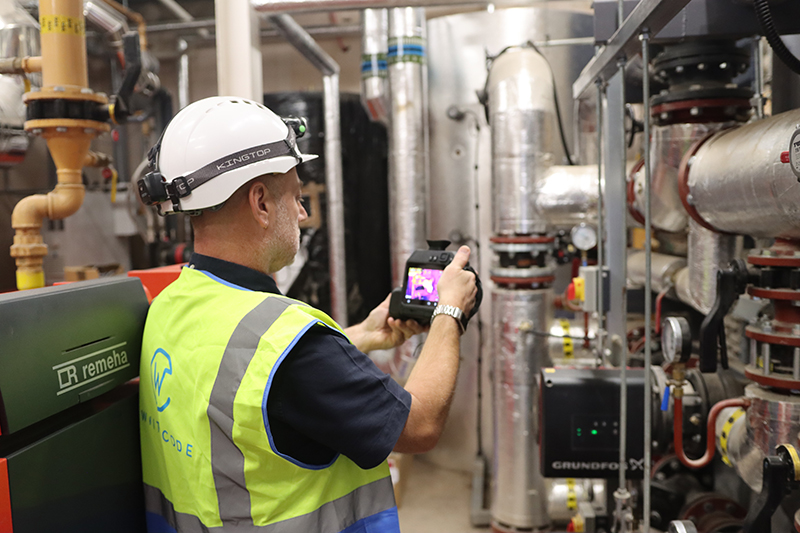
The UK’s 2050 net zero target is increasing demand for sustainable solutions and leading property owners and developers to seek further ways of decarbonising heating that don’t involve heat pumps. Charlotte Owen, the growth director at Hemiko, spoke at this year’s Futurebuild on a £1 billion project taking place in Westminster. Alex Hill, MD at Whitecode Consulting, takes a closer look at the project and discusses whether heat networks are becoming an increasingly important opportunity for building owners, architects, and developers.
WITH heating UK buildings currently accounting for 20% of total UK carbon emissions, identifying ways of decarbonising heating is becoming increasingly important for property developers and architects. While the UK Government has been encouraging those in the built environment to specify and install heat pumps as a way of reducing carbon footprints, many across the UK are turning to heat networks – also known as district heating systems.
Transporting heat through a network of underground pipes to any connected buildings through the use of Heat Interface Units (HIU) installed in each property, heat networks are often more energy efficient than individual central heating systems. Furthermore, centralising heat production and the use of cleaner energy sources can reduce air pollution and carbon emissions – vital with around half of UK buildings located in densely populated areas.
Westminster heat network launched
Low carbon heating is becoming a viable option for property developers, architects, and building owners across the UK – highlighted by the new £1 billion infrastructure project launched in Westminster. Known as the South Westminster Area Network (SWAN), this major heat network installation is expected to save 75,000 tonnes of CO2 every year.
Able to supply low carbon heating that’s sourced from the local area, the UK’s first ‘heat network zone’ will harness waste heat from the surrounding region – including the London Underground, the Thames, and the sewer network. This heat will be distributed via an underground network of insulated pipes in a zone that incorporates everywhere from Victoria Station up to Temple Underground Station by the Strand.
This major new project – developed by Hemiko and Vital Energi – is expected to save 75,000 tonnes of CO2 every year and improve local air quality by reducing nitrogen oxide emissions by 99%.
An effective way of decarbonising heating systems
Helping Scotland and the UK drive decarbonisation efforts, heat networks, also known as district heating systems, can further reduce reliance on fossil fuels by integrating with renewable energy sources – such as solar, biomass, or geothermal energy.
By utilising waste heat, or renewable energy sources, heat networks are therefore a highly effective way of reducing carbon emissions – especially compared to traditional gas-fired heating systems.
Improved air quality and occupant comfort
For urban areas with high population density, reducing local air pollution is absolutely essential.
Relying on cleaner energy sources compared to more traditional central heating systems that burn oil or coal, heat networks are becoming a trusted method of improving air quality for building occupants and anyone in the region.
Enhancing occupant comfort not only increases productivity and wellbeing but also makes buildings more attractive to potential buyers or renters – adding more incentives for property developers and building owners to adopt heat networks and other energy efficient processes and systems.
Lower heating bills and maintenance costs
Often cheaper to operate and maintain long-term than individual central heating systems, the cost savings of heat networks can then be passed on to consumers.
Furthermore, heat networks are able to offer more predictable energy costs over time. As a result, building owners and occupants can avoid volatile energy prices that can affect more traditional heating methods, such as natural gas or electricity.
The importance of education and increasing awareness
While heat networks offer significant cost, energy-efficiency, and air quality benefits, just under 2% of Scotland’s heat is supplied from heat networks. This indicates there is still a lack of awareness and education on these benefits and the substantial reduction in carbon emissions they can offer. Additionally, many building owners, architects, and property developers aren’t aware of how to unlock the most efficient systems.
The Scottish Government’s £300 million Heat Network Fund offers substantial financial support to businesses and organisations looking to develop heat network projects. This, alongside the numerous finance and sustainability benefits, gives heat networks the potential to help building owners and property developers across Scotland save money, improve air quality, and reduce carbon emissions.
It is therefore vital that those in the construction industry work together with heat network operators and suppliers to increase awareness of the benefits of heat networks and how they can aid the decarbonisation of UK buildings. Doing so will encourage a more cohesive approach to decarbonisation – for the betterment of the industry now and in the future.











